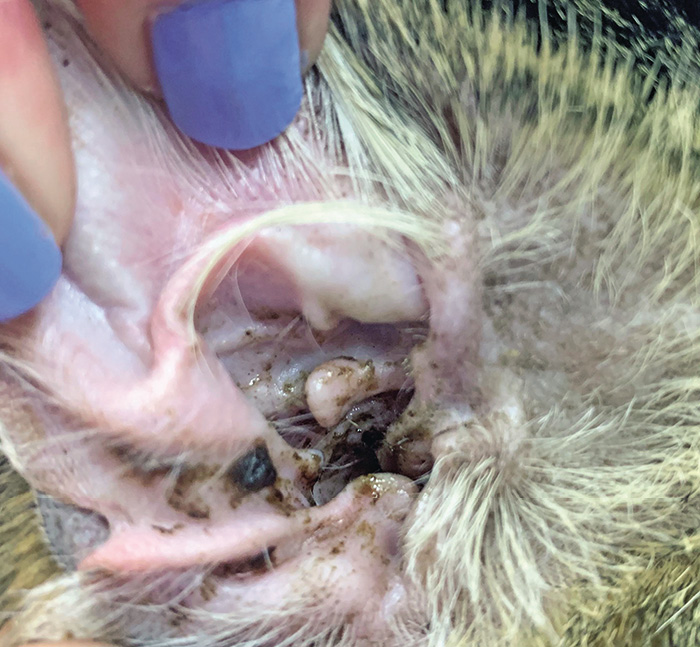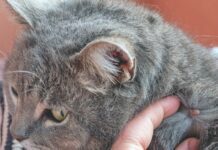Ear problems in cats are a real cause for concern, as they frequently occur secondary to an underlying issue, and they can quickly progress to deeper, more dangerous disease.
Early signs of ear disease include:
- visible discharge from the ear canal
- redness and odor in the ear canal
- head shaking
- scratching at the ears
- painful ears
- swollen ear flap
Exterior Ear
Most cats are initially brought into a veterinary clinic due to an external ear issue. Underlying causes include parasites (ear mites), allergies, polyps or tumors, and foreign bodies. The age and lifestyle of your cat lends a certain index of suspicion for the likely cause: Ear mites are most common in young kittens; tumors are usually found in geriatric cats; allergies and polyps occur most often in young adult cats; and foreign bodies are the bane of outdoor cats.
When you bring your cat in with a concern for ear disease, your veterinarian will do a full physical exam and check for any evidence of concurrent skin issues. An otoscopic exam will be performed to visually assess the ear canal, all the way to the ear drum. If there is abnormal debris present, samples will be procured to check for ear mites and bacteria or yeast infection.
An important aspect of your veterinary visit is a thorough cleaning of the external canal, which may be necessary for your veterinarian to effectively assess the ear canal and the ear drum. If there’s an ear infection, cleaning is essential for successful treatment, as excessive debris interferes with the effectiveness of any medications that are prescribed.
If infection is identified, topical treatment is typically necessary. Most topical ear treatments include a steroid to treat the inflammatory component that is making your cat uncomfortable. At the end of the recommended treatment course, a follow-up exam is recommended to confirm complete resolution of the infection. Without it, if your cat suffers another episode, there is no way to know if it is a new infection or a flare-up of an unresolved infection. The concern with an unresolved infection is that it can extend deeper into the ear.
If your veterinarian identifies an underlying cause—like allergies, mites, or a foreign body—these will be addressed to help keep your cat’s ears healthy moving forward. Polyps and tumors can be harder to identify in the early stages, as they often originate behind the ear drum and cannot be visualized during otoscopic exam.
If no infection or underlying condition is identified, your cat may simply be an exuberant ear wax producer. This is most common in cats with greasy hair coats. If this is your cat, he needs regular ear cleaning at home and may occasionally require a topical steroid for inflammation. Your veterinarian or veterinary technician can teach you how to safely clean your cat’s ears at home and make recommendations for how often you should do it. (Hint: NEVER stick a Q-tip in there! You can easily rupture the ear drum.)
The Middle Ear
An unresolved simple ear infection can develop into an infection called “otitis media,” which is an infection of the middle ear. You may notice your cat showing pain when she opens her mouth wide, tilting her head, or appearing to have hearing loss, in addition to the signs we mentioned above.
Because of the nerves traveling close to the middle ear, cats with otitis media may have facial nerve paralysis and/or a temporary nerve disorder called Horner’s syndrome (see p. 2) that causes your cat to be unable to blink. Horner’s indicates that a middle ear infection may be present.
Your veterinarian’s otoscopic examination may reveal a bulging, discolored, or ruptured ear drum. Further diagnostics, if needed, might include bacterial cultures, skull x-rays, or advanced imaging, like a CT scan or MRI. Initial treatment usually involves systemic antibiotics and pain medications. Sometimes the middle-ear cavity requires surgical drainage.
Middle-ear infection causes include:
- chronic unresolved external ear infection
- upper respiratory, sinus, or mouth infection
- ruptured ear drum
- polyps or tumors
- nasopharyngeal polyps
Nasopharyngeal polyps are benign, inflammatory polyps that start in the nasal cavity. They are most common in young adult cats. Cats with nasopharyngeal polyps may breathe noisily, snort, or have nasal discharge. When the polyp extends up through the Eustachian tube to the middle ear, otitis media results. Resolution requires surgical removal of the offending polyp.
Inner Ear Inflammation
An unresolved middle-ear infection can journey deeper into the ear. Additional signs that your cat’s ear disease is even more serious include:
- loss of balance
- severe head tilt
- compulsive circling
- eyeballs jerking back and forth
This is an uncomfortable, distressing situation. While there are other causes of a deep ear infection, the most common cause is chronic, untreated middle-ear infections. Treatment is similar to that of middle-ear infections, with the addition of anti-nausea medications.
Bottom Line
What may seem like a minor ear issue can turn into a whole lot of badness if ignored. Pay attention to your cat’s ears and her associated behavior, like scratching at the ear or head tilting. See your veterinarian if anything changes and be sure to keep your follow-up appointment if ear disease is diagnosed. Jumping on that initial minor irritation can avoid a whole lot of suffering for your cat and your wallet




